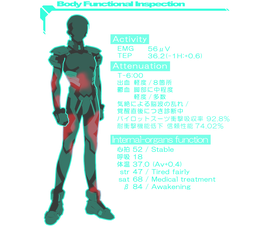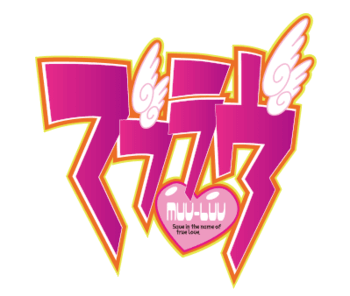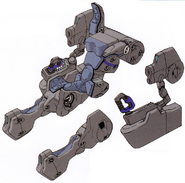
Pre-XM3 Operating System of the TSF
The means by which a pilot can control a Tactical Surface Fighter are mainly from a combination of mechanical controls and neurological system links. Unlike most pilot systems, those used in TSFs are far more advanced, and their technologies are often linked to the history of humanity's space race and TSF development itself.
All TSFs, and derivatives such as those of the Hi-MAERF project, are controlled by a pilot wearing a Fortified Suit. Their commands to the TSF are relayed by the mechanical and neurological controls of the Feedback Interface that they are sitting in, which is in turn connected to a TSF Control Unit that transmits commands to the TSF. Depending on the technology used, features such as Operation By Wire/Operation By Light systems are used as efficiency multipliers in TSF control, as are experimental systems such as the contact control terminals used in lieu of control sticks in the XG-70d Susanoo's cockpit. It is capable of administering Combat Hypnosis to the pilot as well.
Control Units[]
TSF Control Unit[]

View of a sealed TSF cockpit.
- A cockpit system used worldwide, the TSF Control Unit is a standardized cockpit system designed and internationally patented by the Markin-Berger Co.[1] The Control Unit is fully eject-able, usually from the rear of the TSF that it is mounted upon, and contains the electronics needed to slave the TSF's optics to the retinal projectors of the pilot's suits as an advanced form of a Head-Mounted Display system. In the event of a rescue attempt with allied TSFs, the entire Control Unit can be carried off. An exoskeleton system is usually equipped into the system to facilitate a ground-based escape after ejection, and air-inflated cushions can be deployed to soften the impact of landing after ejection.
- Within the Empire of Japan, the system is identified as the Type-92 Control Unit.
Two-Seater Control Unit[]
- A variant of the standard Control Unit with an elongated frame, this version was built to accommodate two people for easier control over a TSF's systems; for example, one pilot might focus only on maneuvering while the other controlled weapons systems. In recent times, improvements in man-machine interfaces and control technology has returned most TSFs to being single-seat machines.
XG-70d Control Unit[]
- A two-seater cockpit system, the XG-70d's cockpit block omits a great deal of modularity in favor of mounting the latest systems in TSF control. The front pilot controls the weapons, while the rear pilot is in charge of navigation.
Training Simulator[]
- A replica of an actual TSF Control Unit, also built by the Markin-Berger Co. and used worldwide, the training simulator features all of the original's control sticks, pedals, and console positions, but is mounted in a fixed housing attached to a base that is designed to tilt/shift the housing's position to match the running of whichever training program is active.[1] In this way, the training simulator is able to replicate the performance of any TSF within a virtual environment, instill muscle memory for users that can also be applied in the operating of actual TSFs, and is good for training fresh cadets without the risks of physical damages or injuries incurred due to inexperience in operating an actual TSF.[1] With the effort involved in running live exercises, the training simulator can also be used by more experienced pilots to train in missions with minimal fuss.[1]
- Its only failing is its inability to fully replicate g-forces with housing movement alone, which it compensates for by using the pilot's own Fortified Suit to send electrical signals to muscles and nerves to "trick" them into feeling the same effects they would experience with actual application of g-forces.[1]
Control Unit Features[]
JIVES[]
- JIVES (Joint Integrated Visualization Emulator System)[2] is a virtual simulator program system considered one grade higher than the normal TSF simulator system, and is utilized to train both new pilots and veterans.[3] The program is utilized by pilots operating actual TSFs, and is able to accurately process and replicate minute details like allied data-link, the reduction of weight from a TSF expending its ammunition, damage dealt to TSF components, and the like,[3] by calculating the effect it has on a TSF and changing its real-time performance accordingly. Using these capabilities, large-scale exercises can be put into motion to provide a realistic simulation of any possible scenario.
- JIVES also has the capability to simulate the behavior of all known BETA classes by presenting them as virtual targets within the pilot's vision, and can accurately replicate the behavior of each BETA strain to present a realistic training experience for veterans and new pilots alike.[3] In this manner, special scenarios that are typically rare, if not impossible to replicate for training, such as Hive infiltration missions, can also be repeated for the participants without the accompanying high levels of danger per mission run.[3]
Combat Hypnosis[]
- A variant of hypnotic suggestion intended for battlefield uses, most commonly to reduce and head off incidences of poor morale, panic attacks and lack of willpower. Usually used in conjunction with drugs and stimulants injected by a Fortified Suit into a pilot's body, this can cause pilots to calm down and/or become more aggressive in combat, with accompanying side effects.
Exoskeleton Systems[]
Type-87 Feedback Interface[]

Type-87 Feedback Interface in exoskeleton mode.
- A cockpit seating system with a moving frame that partially covers the wearer's body when deployed, the Type-87 Feedback Interface serves both as the control system of the user's TSF when attached to a Feedback Protector, and as an escape system for any pilot stranded behind enemy lines. The Feedback Interface is primarily a control system that aids the pilot with indirect thought control (via the seating surfaces of the Feedback Interface), minute limb movements transmitted to the TSF, and protection for the pilot from high-G forces by locking him/her into the seat via the Fortified Suit.
- As an escape system, the Feedback Interface assumes a bipedal form with light armor encasing the pilot, and is commonly used when heavy frame damage has rendered the Feedback Protector unusable. By detaching from the Feedback Protector (commonly referred to as Powering-Out), the Feedback Interface becomes a light exoskeleton system with the capability for a pilot to bear up to ten tons of weight.
Type-89 Mechanized Infantry Armor[]

A Type-89 Feedback Protector.
- A self-contained powered armor system developed for emergency purposes, this Feedback Protector-type equipment, which originated from the US-made Hardiman, is used in a different role from its predecessor. Firstly, the system is stored in the Type-92 Cockpit Block as a fallback for pilots that need to eject from their TSF; the Type-89 can be attached to the Type-87 Exoskeleton the pilot is already wearing in such an event, amplifying the speed and strength of the escaping pilot.
- Likewise for a suit system not designed for combat, the Type-89 Feedback Protector lacks armor in several key areas, instead relying on mobility to provide protection. Despite its shortfalls in combat, the base design is versatile enough that the UN has refitted several of these units to serve as equipment for security troopers in Yokohama Base. The associated fortified suit used to interact with these systems by mechanized infantry is called the Type-73 suit.
Fortified Suit[]

Efficient combat requires a clear mind and heart.
The Surface Pilot Fortified Suit[4], or simply Fortified Suit, is the standard pilot suit of all pilots operating TSFs, designed to protect all pilots from the risks and rigors of piloting a TSF. Its midsection is made of a reactive material that hardens upon detecting a sudden shock or blow, and a strong neck brace protects pilots from suffering neck injuries during high-G maneuvers. The entire suit is locked into the pilot seat via two locking bolts at the lower back and four more in the suit's lower leg regions.
Despite its apparent material thinness, the suit can insulate the pilot from moderate differences in external temperatures, and contains electronics to regulate and record a pilot's vital signs. All these functions are run by a battery pack that can stretch up to 72 hours in usage when running at the bare minimum; it can last for 12 hours running all systems at maximum, and when the pilot is seated in a TSF the battery will automatically refill its charge from the TSF's power source. The Fortified Suit is also equipped with the latest in combat avionics and pilot systems; its headset is capable of high-resolution retinal projection of combat data without the need of a display screen, and can remotely connect to the TSF's comms system within a 400-meter radius. The suit also constantly records and compares the pilot's performance and reactions with older data to allow for easy analysis of combat records, allowing for improvement on the pilot's part.

A HUD readout of another pilot's body condition.
At its core, the Fortified Suit is a highly-advanced development of 1960s spacesuit technology; not only can it hold advanced electronics, but it can monitor and handle human functions as well. The Fortified Suit has the capability to inject drugs and stimulants directly into the wearer's body, and has a water pack that can hold up to 2 liters of liquid; in an emergency, an on-board filtration system can purify the pilot's urine into potable water. Storage of feces is also possible up to 500 grams; however, the synthetic food served to frontline troops and field rations are engineered for maximum digestibility and contains drugs that suppress intestinal functions, making this a minor concern.
The midsection coloring of the suits vary from model to model. Trainees are usually given light-colored suits to help instructors quickly identify signs of bleeding and other injuries; the midsection material can be quickly dissolved or torn if in the way. The form-hugging suit also has another psychological function; to represent equality and tear down civilian concepts such as modesty between men and women, since the harsh reality of the battlefield makes no distinction when it comes to gender. Combatants are issued different suits depending on which nation and which branch of the armed forces they serve. An external jacket is also provided for the pilot in the event of outdoor work.
The fortified suit armored sleeves are the most common area used to display the pilot's squadron and branch/allegiance. The left arm is used to display the squadron's icon and name (e.g Black Knives), while the right side is used for the military branch (e.g US Marine Corps) or organization (e.g European Union Force) the pilot is a part of.

Fully enclosed helmet, IRG. 1998.
A helmet has been developed with a large spherical visor which provides the pilot with a largely unobstructed view while at the same time provides physical protection against head trauma in the case of damage to the cockpit from BETA attack or collisions. In addition, the helmet is designed to provide filtered, breathable air for pilots taking part in ground operations where the air is either contaminated with hazardous materials (chemical or radioactive particles) or there is an absence of breathable air due to the lack of atmosphere.
Fortified Suit Types[]
Japanese Fortified Suits[]
The Japanese use the same model of Fortified Suits as the UN; within the Empire, the suit is known as the Type-99 Fortified Suit. The Imperial Royal Guards have their own Fortified Suit for better interface performance with their Type-00s. The initial fortified suit deployed by the Empire, used by both the IJMDF and the Guard, was called the Type-77 and was deployed concurrently with the acquirement of the Gekishin.
The Type-73 Fortified Suit is used to interact with the Type-89 Feedback Protector, a combat variant used by mechanized infantry brigades to augment their combat ability against the smaller BETA strains. It was originally conceived of after the development of the Hardiman exoskeleton made for lunar combat.
American Fortified Suits[]
US armed Forces Fortified Suits, designated Type-86 for their year of deployment, are used across their military with color schemes denoting the branch of the military that an individual serves in. Their Fortified Suit model is also used by countries around the world, including the Unified Front of China, Canada, Turkey, and Nepal. The licensed foreign export model of the fortified suit is referred to as the Type-91 line.
European Fortified Suits[]
The amalgamation of countries and cultures that make up the European Union Force means that while they may have standardized the equipment used, their apperance and colors vary from country to country, or even from squadron to squadron.
Soviet Fortified Suits[]
While Soviet military Fortified Suits all share a basic design, variations in color and equipment for specialized units exist. The current Soviet fortified suit has been in service since 1989, offering it the Type-89 designation. The customized fortified suits used by Cryska and Inia were produced in 1997, referred to as the Type-97 suit, and is used by other Espers involved in the Total Eclipse plan, or who are otherwise in the elite esper pilot corps.
Unidentified & Unique Fortified Suits[]
Certain pilots in the Muv Luv universe have had their fortified suits custom tailored for one reason or another. One such suit model worn by Christopher of the RLF has several visual differences from existing Fortified Suit models. A fortified suit was designed especially for the 00 Unit during its operation of the XG-70. Similarly, Yashiro Kasumi used a visually unique fortified suit when she acted as co-pilot in the XG-70 Susanoo.
Trivia[]
- The design of Fortified Suits bear strong similarities to the Entry Plug Suits from Neon Genesis Evangelion.
- The function of the Feedback Interface is similar to the EX-GEAR from Macross Frontier.
- The Type-92's manufacturer, Mirkin Berger, is a possible reference to real-life manufacturer of ejection seats Martin-Baker. However, the real-life Martin-Baker Company Ltd. is a British company, as opposed to Mirkin Berger's American origins.
- The specifications of the Control Unit are very similar to those in the spaceships used in the Apollo Program.
- A visual error rife in Total Eclipse material is the lack of unit and branch identification patches on Soviet fortified suits. Whereas Fikatsia Latrova is correctly seen with the Zhar Battalion patch in the Visual Novel, she lacks both it and the Soviet Army patch in the Anime. Her subordinates lack any insignia at all.















































